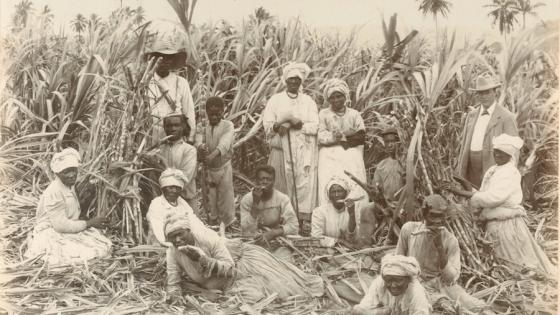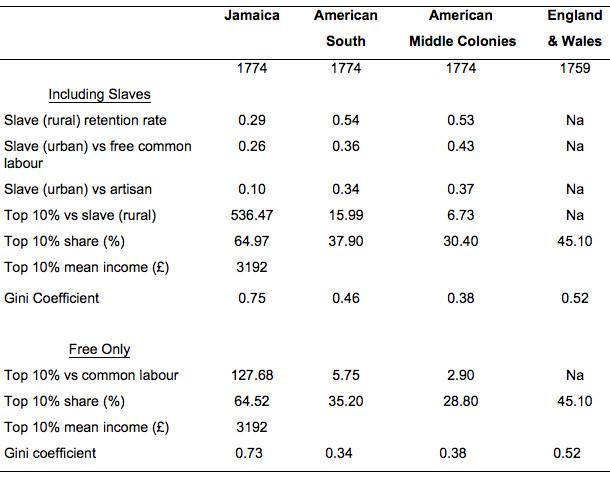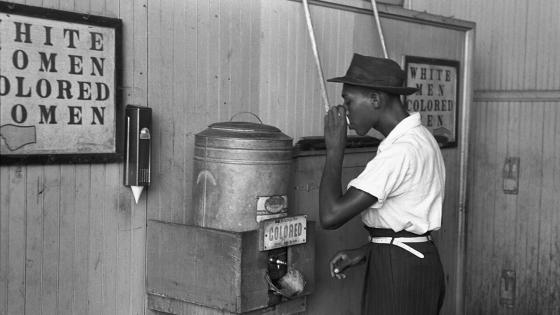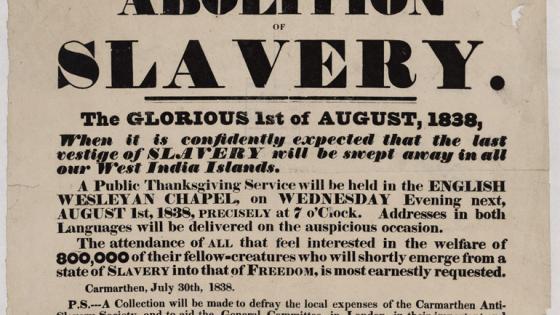Recent work on the colonial British American and the early US economies has renewed debate about income inequality among their populations before and immediately after the American Revolutionary War. Peter Lindert and Jeffrey Williamson (2016) have shown that Benjamin Franklin was right to argue in 1750 that the British North American economies, especially where slavery was relatively unimportant, were remarkably egalitarian. Native Americans and African-Americans would certainly have countered Franklin’s claims, given white supremacy, but America was far more egalitarian than Europe even including slaves.
Franklin has been proved correct about American equality in the colonial era. He was also correct to argue that Britain was wrong to support plantation systems based on African slavery, since their profitability was not nearly as great as contemporaries thought. Moreover, what economic prosperity these plantation societies generated depended on the impoverishment of slaves who produced the tropical export crops – tobacco and especially sugar in Jamaica – that were transforming British and American society in the 18th century. Franklin provided one of the first, and most compelling, cases against imperial support for slavery.
One reason that the British government so strongly supported plantation slavery in the West Indies was due to the great revenues that it brought to the imperial state. As such, slavery generated imperial economic benefits. Both contemporaries and modern historians thought that Jamaica was especially rich. Certainly, its wealth was extraordinary, enough so that Patrick Browne could claim in 1756 that Jamaica was “the richest…colony…under the government of Great Britain.”
But this wealth was so unevenly distributed that Franklin dismissed slave societies as malign places of severe inequality. So little of the wealth went to those producing it in the cane fields that Jamaica should, he said, be seen as a place of great poverty rather than of great riches. Previous studies have obscured this fact because they have taken 18th century mercantilist estimates of value as their metric, thus ignoring the miserable living standards of slaves (and most free unskilled labour, both white and black) while stressing instead the great wealth of a few white Jamaican plantation owners and merchants.
In recent work, we use an increasingly common methodology adopted by economic historians to assess pre-industrial living standards and inequality in colonial Jamaica (Burnard et al. 2017). We construct a so-called social table for 1774 Jamaica, like the one done for Britain in the late 17th century by Gregory King, to assess income by occupation. We think that our social table offers a reliable estimate of the annual nominal incomes of white and free black Jamaicans ranging from wealthy planters and merchants down to paupers. It also allows us to estimate the in-kind nominal income of slaves. The social table is used to construct the inequality estimates reported below. Next, we use relatively abundant price data to compute the relative purchasing power of an average Jamaican working class household as well as that of a subsistence basket of bare necessities received by a slave. We follow here the methodology advanced by Robert Allen in several publications on global living standards in the 17th and 18th centuries. This methodology also allows us to compute so-called welfare ratios (the number of market baskets nominal incomes could buy), which allow us to compare Jamaican living standards with British North America, colonial Latin America, and Europe. The results are surprising and significant.
- First, welfare ratios were exceedingly low for all Jamaican unskilled, both free and slave.
They were 0.41 for slaves (that is, they consumed less than half of a free white subsistence basket), while the figure was 0.94 for white paupers and still only 1.56 for free unskilled labour. It was 247 for sugar estate owners. The huge gap between slave and master can best be seen by the ratio of slave ‘income’ to that of the top 10%, 536 in Jamaica compared with 16 in the American South, as illustrated in Table 1.
- Second, Jamaica seems to have been the most unequal place on the planet, at least among those for which we have the evidence.
The Gini coefficient reported in Table 1 summarises these immense income gaps – it was an extraordinary 0.75 in Jamaica including the slaves, and it was still an enormous 0.73 excluding the slaves, both well above Franklin’s middle colonies of British North America (0.38), and even well above the American South (0.48 including slaves, 0.38 excluding slaves). The figure for unequal England was 0.52. Indeed, the island economy recorded by far the highest inequality for any pre-industrial economy that can be documented (Milanovic et al. 2011, Figure 2), including British India. Furthermore, given Jamaica’s estimated per capita income in the late 18th century, its inequality far exceeded the limits dictated by the Milanovic-Lindert-Williamson inequality possibility frontier, defined as that level of inequality which supplied only a survival level of subsistence for the majority at the bottom, and thus the maximum surplus that the elite at the top could squeeze out. Jamaica obviously exceeded that maximum condition, since its low nutrition, hard-driving work intensity, and resulting high slave mortality required the import of new slaves to replace them.
Table 1. Comparative income inequality: Gini coefficients, income shares and income ratios
Source: Burnard et al. (2017: Table 7).
- Third, Jamaica had very high costs of living.
It imported a substantial portion of its food requirements from North America and its manufactures from Europe, and this during a pre-global era when long-distance trade in staples was expensive. Planters preferred to import foodstuffs and other goods from outside the island rather than sacrifice land and labour used for export crops to produce foodstuffs and manufactured goods. In 1774, the cost of a subsistence market basket (in grams of silver) was 393 for Jamaica, 278 for London, 211 for Amsterdam, and 203 for Boston. That is, Boston living costs were only 52% of those in Jamaica. Things got even worse in times of crisis. The largest crisis in 18th century Jamaica came after 1778, when France and Spain entered the War for American Independence on the American side. Subsequently, Jamaica faced severe blockades. Its cost of living skyrocketed between 1778 and 1782. In 1779, the subsistence market basket cost 1621 grams of silver in Jamaica, 246 in London, 168 in Amsterdam, and 249 in Boston. Even in the best of times, Jamaica’s high cost of living made it very difficult for whites outside the plantation sector to prosper, and for free unskilled – competing with cheap slave labour – to escape poverty.
The Jamaican elite dealt with this poverty problem by constructing an extensive welfare system. To support poor whites, rich Jamaicans were taxed more heavily than British Americans. Those taxes were spent on poor relief, but also on military and police, mainly to prevent slave rebellion and foreign invasion. Free blacks were largely ignored and enslaved blacks got no welfare provision at all. Thus, slaves suffered especially badly in times of subsistence crisis, notably during the War for American Independence.
Our analysis shows that Jamaica was markedly different than other British colonies, notably the northern American colonies whose prosperity and equality Franklin celebrated. Jamaica had extreme poverty for the majority (all blacks and a considerable number of whites) and huge incomes for the very few (white planters and merchants). It confirms not only that Jamaica was a very expensive place to live with the highest cost of living in the late 18th century (among all places for which such evidence is available). It also confirms the especially brutal nature of slavery on the island. If the Pennsylvania of Benjamin Franklin’s time was the “best poor man’s country” on earth, Jamaica ranked among the worst – almost all of whom, of course, were black slaves and thus thought of as property, not people. In contrast, most poor people in Franklin’s Pennsylvania were white. Jamaican slaves lived at the bare edge of subsistence even in good times. Slaves were worked excessively hard, and lived short lives.
Our analysis of Jamaican living standards in 1774 shows that colour and status made all the difference. The interests of a few whites, not of the many blacks, took precedence in imperial assessments; it is hardly surprising that Jamaica was considered very rich when it was, in fact, very poor.
References
Burnard, T, L Panza, and J G Williamson (2017), “The social implications of sugar: Living costs, real incomes, and inequality in Jamaica c.1774”, NBER Working Paper 28893.
Franklin, B (1750/1961), "Observations on the Increase of Mankind", in L W Labaree et al. (eds), The Papers of Benjamin Franklin, New Haven: Yale University Press.
Lindert, P H and J G Williamson (2016), Unequal gains: Growth and inequality in America since 1700, Princeton.
Milanovic, B, P H Lindert and J G Williamson (2011), “Pre-industrial inequality”, Economic Journal 121: 255-72.







